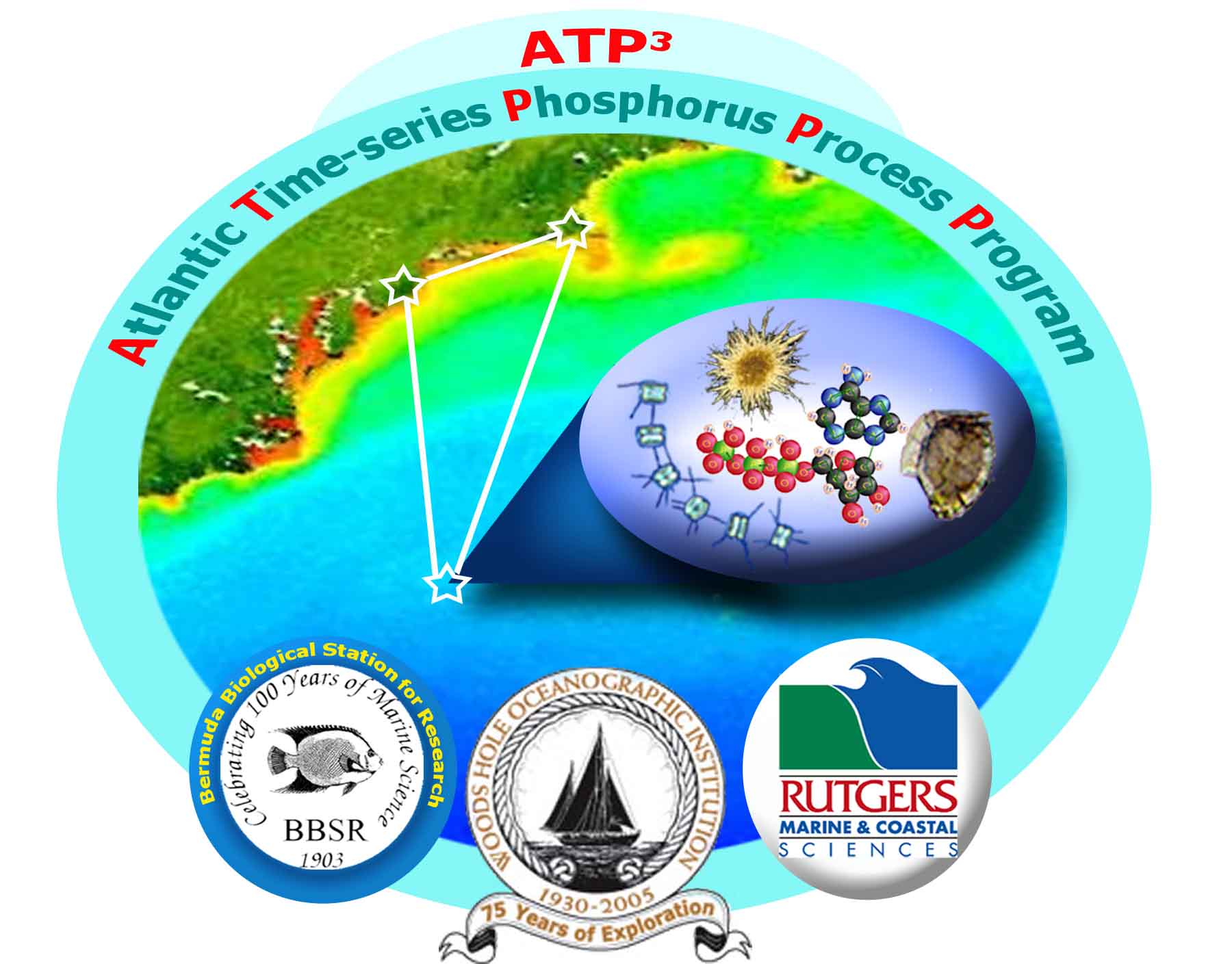 ©2020 Biological and Chemical Oceanography Data Management Office.
©2020 Biological and Chemical Oceanography Data Management Office.Funded by the U.S. National Science Foundation
Photosynthetic uptake of CO2 by oceanic phytoplankton and the export of the resulting organic carbon to the deep sea comprise a 'biological pump' capable of extracting globally significant amounts of CO2 from the atmosphere. Mounting evidence suggests that primary production in two of the larger subtropical ocean gyres, the Western Tropical/Subtropical Atlantic and the North Pacific Subtropical Gyre (NPSG), may be controlled by the availability of inorganic phosphorus. This conclusion is based on vanishingly low inorganic phosphorus (SRP) concentrations, sub-nanomolar in some locales, ratios of inorganic nutrient availability that greatly exceed the canonical Redfield Ratio, and high rates of dissolved organic phosphorus (DOP) hydrolysis.
Indeed, data collected in the Sargasso Sea shows a 30% decline in DOP inventories during summer stratification. Moreover, several studies have documented significant taxonomic variability in the ability to hydrolyze and to assimilate phosphorus from organic sources We hypothesize that despite rapid turnover times, chronically low and seasonally invariant SRP concentrations at BATS cannot support measured rates of primary production without utilization of additional P from the DOP pool. Moreover, we hypothesize that inherent physiological differences among microbial taxa represents a significant source of temporal and spatial variability in DOP utilization rates that is yet neither understood nor constrained.
Our specific research objectives are:
1. To quantify temporal and spatial variability in DOP hydrolysis in the Sargasso Sea with measures of whole-community and taxon-specific alkaline phosphatase
2. To quantify temporal and spatial variability in taxon-specific SRP and DOP uptake rates by combining flow cytometry and radioisotope methodologies.
3. To quantify whole-community total P uptake rates through BAP (biologically available phosphorus) assays, as well as SRP and model compound DOP uptake and regeneration rates.
4. To identify factors regulating rates of DOP hydrolysis and assimilation using experimental nutrient manipulations, and to evaluate the role of DOP in supporting primary production in the Sargasso Sea.
To successfully meet our objectives, we propose to employ three cruise sampling strategies: CORE, PROCESS, and CRUISES OF OPPORTUNITY. The CORE cruises and CRUISES OF OPPORTUNITY will be conducted in conjunction with the BATS biogeochemical time-series program. The PROCESS cruises are principal-use cruises that are designed to allow a more intensive study on the mechanisms of and controls on DOP hydrolysis and utilization in the Sargasso Sea.
An understanding of ocean ecosystem function is important on a broad scale. This project will provide information critical for successful modeling efforts constrain predictions of the strength of the oceanic biological pump, as well as provide information of interest to students, teachers and the general public. If in fact DOP supports a significant, and previously unquantified, fraction of the annual primary production in the Sargasso Sea, then diversity in biological metabolic processes in the central oceans plays a greater role in the global carbon cycle - including regulation of atmospheric CO2 - than we recognize at present. The overall goal of the student teaching/training programs at BBSR, WHOI and Rutgers is to expose students to oceanographic research, its global significance, and its impact on their daily lives. As such, we will incorporate data on DOP cycling in the Sargasso Sea into a problem-based learning module for courses taught by the PIs and submit our curriculum to the appropriate digital repository (e.g. www.dlese.org). The PIs have a strong commitment to direct mentoring, and they will also sponsor a minimum of three undergraduate researchers each year in their laboratories, and support the research and training of MIT/WHOI Joint Program and Rutgers University graduate students.
| Dataset | Latest Version Date | Current State |
|---|---|---|
| CTD data from R/V Atlantic Explorer X0606, X0705, AE0810 in the Western Sargasso Sea roughly 38-20N and 66-43W from 2006-2008 (ATP3 project) | 2011-12-06 | Final no updates expected |
| Cruise event logs from R/V Atlantic Explorer X0606, X0705, AE0810 in the Western Sargasso Sea roughly 38-20N and 66-43W Water from 2006-2008 (ATP3 project) | 2011-12-06 | Final no updates expected |
| Biogeochemistry Data from R/V Atlantic Explorer X0606, X0705, AE0810 in the Western Sargasso Sea roughly 38-20N and 66-43W from 2006-2008 (ATP3 project) | 2011-12-06 | Final no updates expected |

Principal Investigator: Michael W. Lomas
Bermuda Institute of Ocean Sciences (BIOS)
Co-Principal Investigator: James Ammerman
Stony Brook University (SUNY Stony Brook)
Co-Principal Investigator: Sonya T. Dyhrman
Woods Hole Oceanographic Institution (WHOI)
Contact: Michael W. Lomas
Bermuda Institute of Ocean Sciences (BIOS)